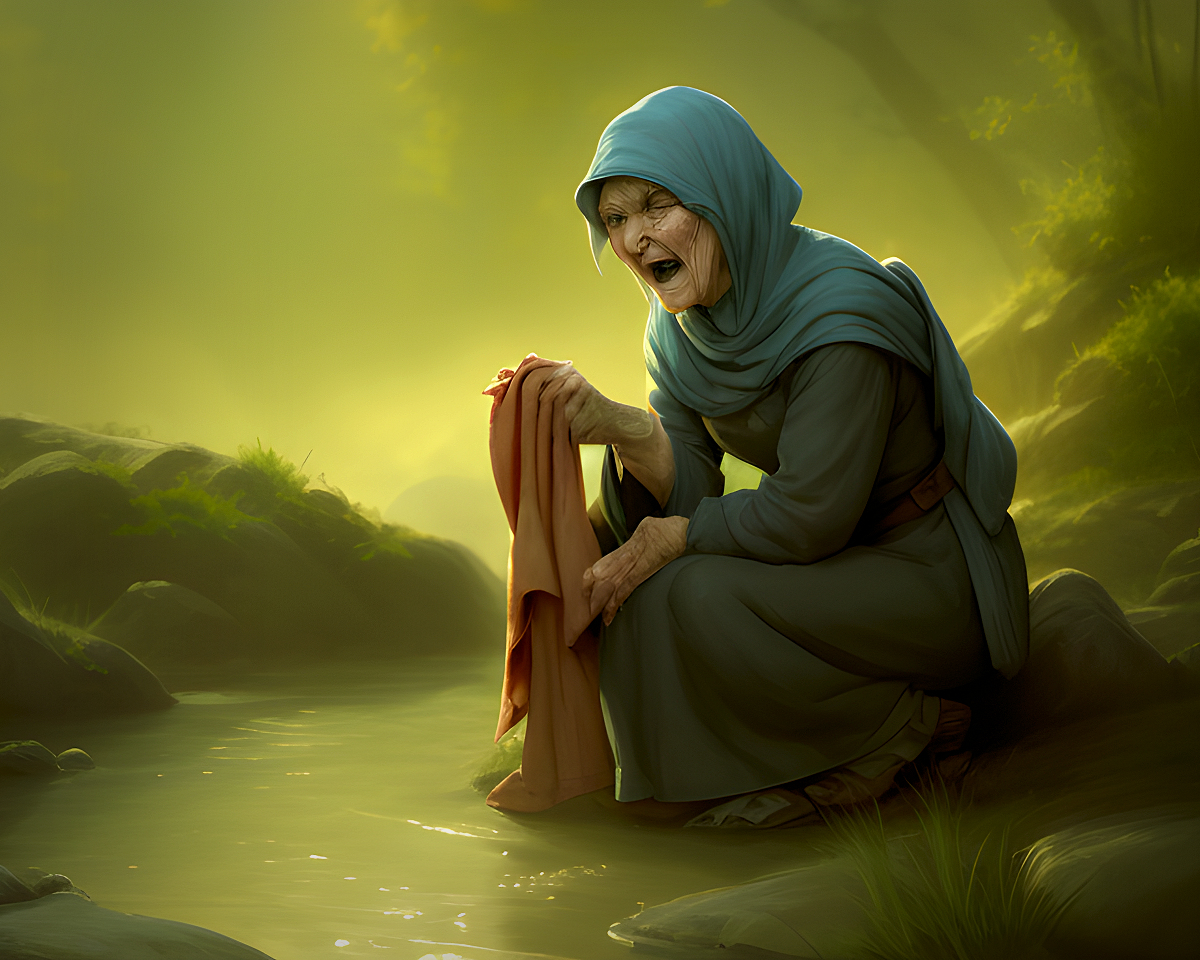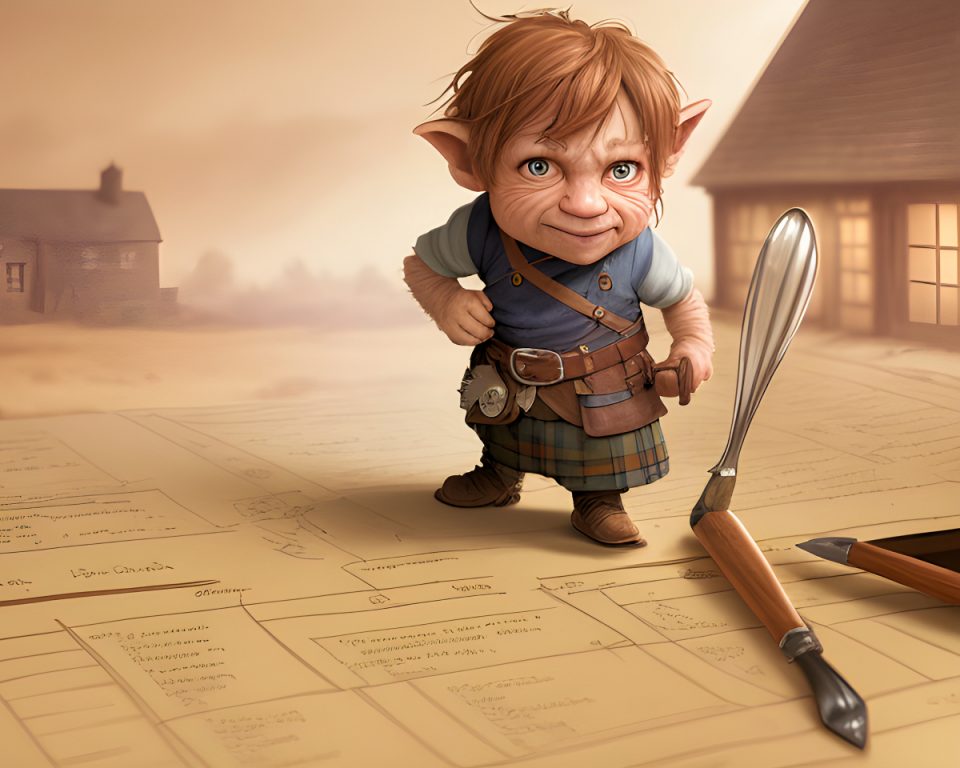The Bean-Nighe, a banshee often referred to as the washerwoman, is frequently seen by solitary water bodies like streams, pools, and particularly fords, scrubbing blood from the clothing of those close to death. This banshee serves a dual purpose, signalling impending death while occasionally acting as a messenger from the Otherworld.
In Scottish Folk-Lore and Folk Life, Donald Mackenzie states that the Bean-Nighe would sometimes sing a mournful song while she worked, if a person was about to meet a particularly violent end. If you captured her, she may grant you three wishes. John Gregorson Campbell hypothesizes that the Bean-Nighe is the spirit of a woman who met her end during childbirth and is now doomed to carry out these banshee tasks until her natural lifespan would have ended. The only method to avert this curse involves washing every piece of the deceased woman’s attire. If one happens to come across the Bean-Nighe and carefully and respectfully approaches her, she may bestow wisdom or fulfil a wish. Numerous tales are tied to her existence with many variations of her behaviour and appearance depending on the locality.
The Bean-Nighe of Mull and Tiree
Campbell recounts the tale of a Bean-Nighe found on the Mull and Tiree islands. This particular Bean-Nighe had an unusual feature. Her breasts were so long that they interfered with her laundry duties; therefore, she would throw them over her shoulders, letting them drape down her back. The poor unfortunates who crossed her path were told never to turn away from her. Rather, they should carefully approach her from behind, gently hold one of her breasts, put it in their mouth, and announce themselves as her foster child. She will then answer any questions from her foster child, including whose clothes she is washing. If she reveals the clothes belong to an enemy, let her continue her task. However, if it’s a friend or relative, the discoverer has the power to disrupt her washing and save that person’s life.
The Bean-Nighe of Skye
The Bean-Nighe who was said to haunt the Isle of Skye resembled a small child. If a person spotted her first she would reveal their fate to them, but they must also truthfully answer any questions she might ask. However, should this Bean-Nighe spot the person first, then they would lose the use of their limbs.
The Bean-Nighe of Islay
On Islay, there was said to be a Bean-Nighe, who showed many similarities to Caoineag. The Caoineag was another Banshee-type character, another washerwoman who despised interruptions so much that, if you disturbed her, she would thrash your legs with a water-soaked plaid, until your legs no longer worked.
The Bean-Nighe and Clanranald
Long ago the Clan Chiefs had attendants called gillies. One of these gillies had the title gillie-cas-fliuch or gille wetfoot. It was his duty to carry his master over streams. And so it was, that Clanranald’s gillie-cas-fliuch was returning home one night when he encountered a Bean-Nighe at a lochside.
The folklorist, Alexander Carmichael, recorded in his collection, Carmina Gadelica:
‘ Gille-cas-fliuch ‘ went gently and quietly behind ‘ nigheag ‘ and seized her in his hand.
” Let me go,” said ‘ nigheag,’ ” and give me the freedom of my feet, and that the breeze of reek coming from thy grizzled tawny beard is anear putting a stop to the breath of my throat. Much more would my nose prefer, and much rather would my heart desire, the air of the fragrant incense of the mist of the mountains.”
” I will not allow thee away,” said gille-cas-fliuch, “till thou promise me my three choice desires.”
“Let me hear them, ill man,” said ‘nigheag.’
“That thou tell to me for whom thou art washing the shroud and crooning the dirge, that thou wilt give me my choice spouse, and thou wilt keep abundant seaweed in the creek of our townland as long as the carle of Sgeir-rois shall continue his moaning.”
” I am washing the shroud and crooning the dirge for Great Clanranald of the Isles, and he shall never again in his living life of the world go thither nor come hither across the clachan of Diinbuidhe.”
Gille-casfluich rushes to Clanranald
‘ Gille-cas-fliuch ‘ threw the shroud of death into the loch on the point of his spear, and he flew home hard to the bedside of Clanranald. He told everything that he saw and heard and that befell him. Clanranald leapt his hard round leap onto his feet from the heath-bed, and he ordered a cow to be felled and a little coracle to be made ready. A cow was felled accordingly, and a little coracle was constructed in which Clanranald went from the island over the loch to the mainland, and he never again returned to Dun-buidhe in the upland of Benbecula.’
The Mermaid of Loch Slin
In this story, the Bean-Nighe in question is also referred to as a mermaid. The account unfolds on a peaceful Sunday morning when a lass from Cromarty was walking alongside Loch Slin. As she ventured round a bend, an unexpected sight met her eyes. A towering woman standing in the water, busily washing garments on a stone. Littering the nearby ground were over thirty clothes, all marred with blood stains. Although the maiden found the sight peculiar, she continued on her journey. Only later did the realization dawn upon her that this unusual encounter had taken place just before a tragic incident at Fearn Abbey. The abbey’s roof caved in, resulting in the untimely death of thirty-six souls. Remarkably, this tale aligns with verifiable historical facts: in 1742 the roof did indeed collapse.
Factfile
Name Pronunciation:
“Bean-Nighe” is a Gaelic term. The pronunciation can vary slightly depending on the region, but a general approximation would be “BAN NEE-yeh.”
Bean-Nighe Appearance:
Generally, the Bean-Nighe is described as having one nostril and webbed feet. However, there are regional variations in the appearance of the Bean-Nighe.
However, on the Isles of Mull and Tiree she was said to have unusually long breasts which she throws over her shoulder, so they hang down her back.
Meanwhile, on the Isle of Skye, the Bean-Nighe allegedly has a squat figure resembling a “small pitiful child”.
In Perthshire, she was somewhat similar in appearance to the Skye Bean-Nighe being small and rotund. However, she is dressed in green.
Bean-Nighe Habitat:
The Bean-Nighe is said to dwell near bodies of water, specifically at fords or riverbanks, where she can be found washing bloodstained clothing or burial shrouds. She is often encountered at dusk or during the night when she carries out her haunting tasks.
Bean-Nighe Behaviour:
The Bean-Nighe is believed to be a harbinger of death and a foreteller of misfortune. Her appearance at a Ford is seen as an omen that someone nearby will soon meet their demise. She is known to wail and keen mournfully, expressing grief for the impending loss. In some tales, she is seen as a guardian of sorts, warning those who encounter her of their impending fate.
Variants:
The concept of a female spirit associated with washing clothes and death appears in various cultures. In Irish folklore, a similar figure called the “Banshee” is often associated with death and is known for her wailing cries. In France, a similar figure is known as Les Lavandières. The Caoineag, such as the harbinger of the Glencoe Massacre, is closely related to the Bean-Nighe.
Bean-Nighe Location in Scotland:
Legends and stories of the Bean-Nighe can be found throughout Scotland. She is particularly associated with specific regions, including the Highlands and the Western Isles. Local tales and folklore often mention encounters with the Bean-Nighe near rivers, fords, or other bodies of water.




